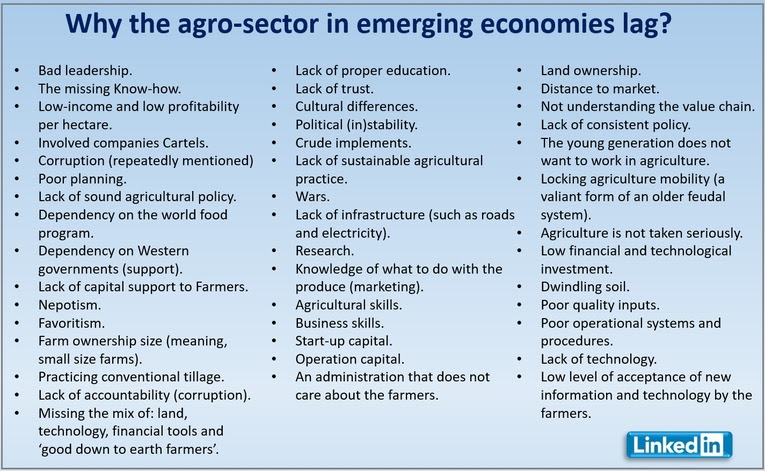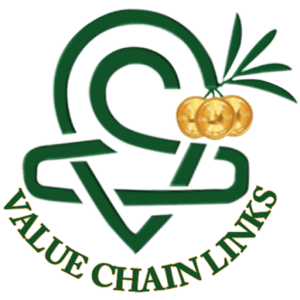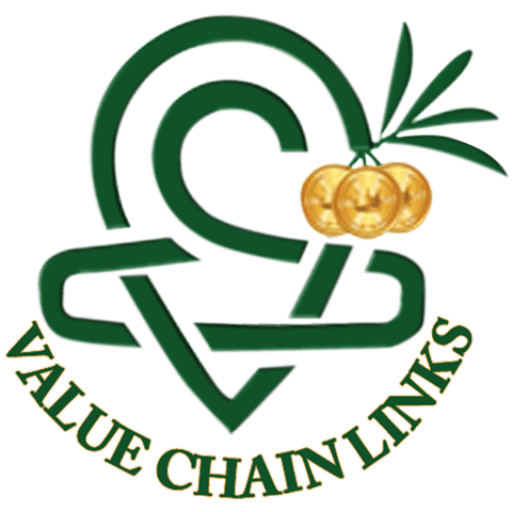WHY AFRICAN AGRICULTURE LAGS; ANALYSIS IN THE LIGHT OF ORGANIZATIONAL THEORY

BY DR. NIMROD
In recent years, I have devoted thousands of hours to study and learn the scope of the following question: Why is agriculture in Africa far less advanced than the West and not realizing its potential?
This raises two key questions:
1) What is the potential of the African agro-industry?
2) What is preventing Africa from achieving global leadership in agriculture?
Regarding the first question, objectively, the African agro-industry potential can be calculated as a total sum of its components. For example, we can calculate the potential based on total arable land, climate suitability, radiation (sun), water resources, labor availability, etc.
In such a case, we would find an imaginary potential greater in magnitude than that of Europe.
Regarding the second question, there are many and varied answers to this question. Some common responses include insufficient technology, finance, and education, in addition to rooted corruption. When I asked my colleagues on social media, I received many answers (see illustration).

We can conclude from the above that the “agriculture in Africa is far less advanced than in the West and its potential is unfulfilled”. This is not because the West’s potential is greater or Africa’s potential is minor, but because of “other reasons”, primarily internal to African countries.
If we think of countries as big “organizations”, we can analyze the above question from a different perspective, the perspective of an organization management expert.
DR. ITZHAK ADIZES’S ANSWER
Dr. Itzhak Adizes is a globally renowned expert in Organization Management. Leadership Excellence Journal ranked him among the “Top Thirty Thought Leaders of America”.
It is, therefore, interesting to analyze the above questions and assumptions in the prism of his theories.
I never asked, in person, Dr. Adizes for his opinion as to WHY there is a wide gap between the potential and the realities of agriculture in Africa.
However, his theories, describing Cause & Effect, have an “opinion” and unique perspective on probable causes of the wide gap.
According to Dr. Adizes organization theory –
Organizations have a limited given amount of energy. This limited energy is first invested in internal struggles, and ONLY the remaining energy (the delta) is invested in promoting innovation and improving competitiveness to better compete with other organizations.
This is a universal law affecting all organizations.

Studying and examining the agricultural value chain in several African countries, it seems that the above theory provides a framework explanation to the gap (existence and size) between agriculture in emerging and developed markets.
In contrast, an examination of Israeli agriculture 60 years ago presents the ability to develop thriving agriculture, even under a scarcity of land, water, funding, and using basic technologies, thus reinforcing Dr. Adizes’s theory in present reality.
Make no mistake; all organizations invest a certain amount of energy in Internal Struggles. Hence, the difference between the Less and the More successful organizations is the proportion between the Internal and the External energy invested out of Total Energy capacity.
The more successful organizations have less friction, so they work more smoothly, and like a good engine, it requires less energy to run. Hence, more energy is reserved to invest in innovation and improving competitiveness, which in the long run supports its financial results and survival.
What do you think? Do you agree with Dr. Adizes?
TWO THEORIES, ONE CONCLUSION
Dr. Adizes’s organization theory provides a clear roadmap for how emerging markets need to act to advance their economy, including their agro-sector.
Organization theories suggest saving “organization energy” by “smoothing” its operation. This is often the result of applying a different or novel business model, which improves the organization’s operation.
For different reasons, Prof. Clayton Christianson, in his Disruptive Innovation theory, describes the need for a novel business model as a way to overcome barriers by using less energy to get the same or better business results.
Whether it is the Organization (Dr. Adizes) or the Business (Prof. Christianson) perspective, the conclusion is the same – emerging markets require novel business models to enable the jump-start of their economy, including their agro-sector.
The coming Africa Organization of Technology in Agriculture Conference and Expo 2022 (AOTA) acknowledges the economic importance of introducing novel business models.
The AOTA conference is maybe the first ever to give the focus and stage to presenting novel business models that can bring a dramatic change to the agro-sector, such as the Green Valley business model.
| THE STATEMENTThe underlined statement of the AOTA conference is that technology alone should not be our main focus or point of interest, as it is useless without a complimentary suitable INNOVATIVE Business Model.Smallholders in emerging economies require a business model focused on their financial results rather than technological ones.For example, think of the economic benefit of transferring money using a smartphone application instead of going to the bank and using the service of a bank clerk. Think about the value chain in each business model, i.e., traditional banking versus smartphone application.Improved organization structure leads to improved innovation abilities, including developing more innovative and suitable business models. This reflects on the organization’s overall competitiveness level and ultimately on its financial results.Hence, it is clear that emerging markets’ most urgent need are innovative business models that will enable them to overcome inhibitor factors that hinder the agro-sector progress. As mentioned before, this will be the main topic of the AOTA conference. |
| Please, if you found value in this article, it would mean a lot to me if you send me a comment and share it with your friends. |
Subscribe here for access to exclusive content – SUBSCRIBE.
<script async src="https://cse.google.com/cse.js?cx=1d77d8f35e241eff9"></script>
<div class="gcse-search"></div>
